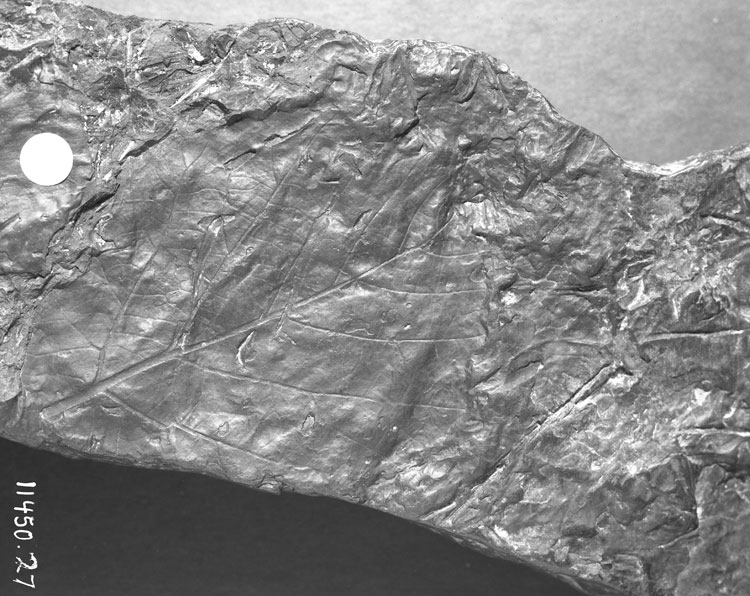Locality
Arctic Slope of Alaska locality USGS 11606, north of Maybe Creek. This locality is a bluff approximately 10 m high on the east side of an unnamed tributary of the Price River. The predominant lithologies are bentonitic clays overlying a silty sandstone capped by coal beds up to 2 m thick, which are in turn overlain by a white-gray medium-grained sandstone. Irregularly dispersed throughout the clay are nodules and sheets of ferruginous limestone (sideritic) which, although light gray when fresh, weather to a rusty brown. With the exception of some poorly preserved plant matter in the upper sandstones, and impressions of platanoid leaves in the power sandtsones, the plant material is confined to these fine-grained iron-rich nodules and is preserved as impressions totally lacking cuticle. There is little evidence of post-mortem decay but many leaves are penetrated by vertical fossil rootlets. Platanoid leaves are most common in siltier/sandier facies. The uppermost coal surface supports several in situ tree bases each of which is approximately 20 cm in diameter.
Latitude: 69.528329 °N
Longitude: -153.887128 °W
Description
Leaf: simple; symmetrical; wide obovate; apex missing, possibly rounded; base auriculate; margin dentate, teeth with acute apices, concave sides and rounded sinuses, variable in size, margin entire at base; venation imperfect marginal suprabasal actinodromous; primary midvein moderate, more or less straight; a-pectinal veins weakly developed and somewhat thinner than the midvein, arising at an angle of 35° from the midvein, uniformly but very shallowly curved towards the apex with some slightly sinuosity near the margin; a-pectinal abmedials given off at varying angles between 35° and 65° but with no regular change in the angle along length of the pectinals; the most basal abmedial behaves as a b-pectinal and gives off b-abmedials; superior secondaries arising at an angle of 35°, moderate more or less straight or very slightly curved and branched abmedially, the number of branches becoming less towards the apex; inferior secondaries weak, strongly recurved; tertiary veins simple or forked, percurrent, straight or convex, arranged more or less concentrically with the point of departure of the a-pectinals from the midvein in the lower half of the lamina, and at a uniform obtuse angle to the midvein in the upper half of the lamina, at the very base of the leaf tertiaries arise from the midvein and recurve into basal lobes; fourth order veins simple more or less straight and orthogonal or branched, tending towards random reticulation in localized areas.
Remarks
The development of actinodromy in this specimen is very weak and the higher vein orders appear to be poorly organized. Where the a-pectinal veins terminate the margin appears inflated and may be representative of incipient lobing. There is insufficient basal lamina region present to determine the degree of palinactinodromy.
This specimen is essentially the same as that named Crednaria truncatodenticulata by Bell (1963, p. 50; Plate 24, Fig. 1) from the Dunvegan Formation, British Columbia.
